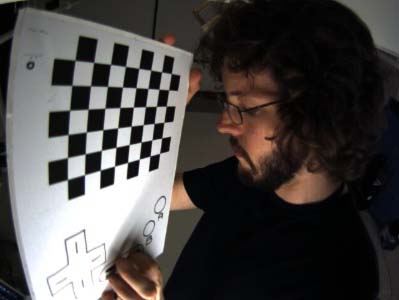physical computing
Wakatta! Lightpen prototyping
Here we see MFADT student Simeon Poulin playing with the whiteboard we cooked up for the first Wakatta test charrette.
- Mike's blog
- Comments
- Read more



- 5910 reads
A Good Week for the Arizonans
Couple of awesome updates. The most important is that Shawn and Kelly from ASU helped Kyle and me set up the SMALLab installation at Parsons. Very, very cool.
 Distortion: Me with a checkerboard as the SMALLab team tries to fix the distortion on the fisheye lenses.
Distortion: Me with a checkerboard as the SMALLab team tries to fix the distortion on the fisheye lenses.
Kyle and I got processing communicating with the system in about a half hour and made a couple of nice sketches with two balls tracking. Should be a good kick off for making lessons starting two weeks from now. Here's a YouTube video of that:
- Mike's blog
- Comments
- Read more



- 4843 reads
Distortion
- Comments



- 10926 reads
LED Wrist Band

A wearable LED wrist band that glows or blinks red, based on button presses. A decent stand-in for a wearable computing device,
- Comments



- 11859 reads
Mill of the Mind In ARTnews!
Our Mill of the Mind project, in which Sims are subjected to the deprivations of the Milgram experiment, got a mention in ARTnews. Awesome!
- Mike's blog
- Comments



- 4609 reads
OpenMoko
A new cell phone? Ho-hum. A new cell phone running on free software? It's been done, but you've got my attention. A new cell phone running on free software, using completely open hardware? And they'll give you the tools to bust it open and make it easy to solder stuff onto its I2C port? RAWK!
Kinda makes you wonder... what would YOU hook up to a cell phone, if you could? Gets me wondering about some of the tech I saw in Malawi, particularly in the health sector.
- Mike's blog
- Comments



- 4805 reads
Pleech Prototype: Building, Testing, Tearing Apart
This week, I started building the prototype of my Pleech, the power leeching wind turbine.
The first thing I did was to assemble all the parts I could find. These included:




With these pieces together, I began the assembly process.
- Mike's blog
- Comments
- Read more



- 4755 reads
More Process
Heh. So, I just realized that I forgot to tag the last entry which would have put the previous Process post appear in the MS:I blog area. Dumb. No wonder Yury didn't see it.
I'm thinking about the Savonius Turbine in particular because of projects like
PicoTurbine.
At 300 windings per stator, the basic version of the PT should be able to produce between two and three volts, according to the authors. The plans have a pretty great discussion of the possible power coming out of the turbine.
- Mike's blog
- Comments
- Read more



- 4854 reads
Process Illustration
For my Pleech project, I am trying to develop a low-cost, low-power, easily assembled generator that can be fixed to walls, fan outlets, and other infrastructure in order to generate environmentally friendly electricity for physical-computing graffiti and sentiti applications.
(Note: "sentiti" is my own coinage. It refers to any illicit sensor that can be placed in much that same way as graffiti. Think of it as an unauthorized reading as opposed to an unauthorized writing.)
- Mike's blog
- Comments
- Read more



- 4981 reads
Sim Art - New York Magazine's Daily Intelligencer
Sim Art - New York Magazine's Daily Intelligencer - [My del.icio.us]
Nice blurb about the Sims show and our project in particular on New York Magazine's site. Both Inti Einhorn and Becky Heritage have great quotes!
- Mike's blog
- Comments



- 4439 reads
tags
Copyright Mike Edwards 2006-2009. All content available under the Creative Commons Attribution ShareAlike license, unless otherwise noted.





